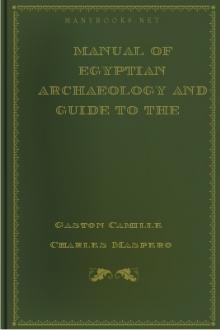Ancient America, in Notes on American Archaeology by John D. Baldwin (best thriller books to read .TXT) 📕

"It is in the form of a serpent, upward of 1000 feet in length, extended i
Read free book «Ancient America, in Notes on American Archaeology by John D. Baldwin (best thriller books to read .TXT) 📕» - read online or download for free at americanlibrarybooks.com
- Author: John D. Baldwin
- Performer: -
Read book online «Ancient America, in Notes on American Archaeology by John D. Baldwin (best thriller books to read .TXT) 📕». Author - John D. Baldwin
“By whom and when was this hill terraced and these stones hewn? There is a mystery hanging around this hill which exists nowhere else in the Sandwich Islands. The other structures so numerously scattered over the group are made of rough stone; there is no attempt at a terrace; there is no flight of steps leading to them; there is no hewn or polished stone, nor is there any evidence of the same architectural skill evinced. They are the oldest ruins yet discovered, and were evidently erected by a people considerably advanced in arts, acquainted with the use of metallic instruments, the cardinal points, and some mathematical knowledge. Were they the ancestors of the present Hawaiians, or of a different race that has passed away?”
He inquired of the oldest natives concerning the history of this ruin, but “they could give only vague and confused traditions in regard to it, and these were contradictory. The only point on which they agreed was that it had never been used within the memory of man.” They also said there was another old structure of the same kind in Kona, whose history is lost. The language of the Sandwich Islands is so manifestly a dialect of the Malayan tongue, that the influence of the Malays must have been paramount in these islands in ancient times.
D.DECIPHERING THE INSCRIPTIONS.
In the “Actes de la Société Philologique,” Paris, for March, 1870, Mons. H. de Charencey gives some particulars of his attempt to decipher “fragments” of one or two very brief inscriptions on the bas-relief of the cross at Palenque. I know nothing of his qualifications for this work, but he appears to have studied the characters of the Maya alphabet preserved and explained by Landa. It is seen, however, that his attempt to decipher the inscriptions is a complete failure. In fact, he professes to have done no more than reproduce two or three words in Roman characters. He gives us Hunab-ku, Eznab, and Kukulcan as words found on the cross. Eznab is supposed to be the name of a month, or of a day of the week, and the others names of divinities. He finds that the characters of the inscriptions are not in all respects identical with those found in Landa, and that Landa’s list, especially when tested by the inscriptions, is incomplete. There is not absolute certainty in regard to the name Kukulcan; nevertheless, M. de Charencey makes this speculative use of it:
“The presence of the name ‘Kukulcan’ on the bas-relief of the cross is important in a historical point of view. The name of this demigod, which signifies ‘the serpent with the quetzal plumes,’ is the Maya form of the Mexican name ‘Quetzalcohuatl,’ which has precisely the same meaning. But we know that the name and worship of this god were brought to the high plateaus of Central America toward the ninth century of our era, consequently the bas-relief in question can not be more ancient.”
This assumes that the worship of Kukulcan was never heard of by the Mayas until the Aztecs arrived in Mexico, an assumption for which there is no warrant, and which proceeds in utter disregard of facts. It was the Aztecs who had never heard of Kukulcan, or, at least, had not adopted his worship, previous to this time. The Aztecs, when they settled in Anahuac, did not impart new ideas, religion, or culture to any body; on the contrary, they received much from the civilization of their new neighbors, which was more advanced than their own. It is very certain that neither the Mayas nor the Quichés borrowed any thing from them.
We need not go back so far as the ninth century to find the time when the Aztecs adopted, or at least organized in Mexico, the worship of Kukulcan, whose name they transformed into Quetzalcohuatl. His worship did not begin with them; they did not introduce it; they found it in the country as a very ancient worship, and adopted their form of it from the people who yielded to their sway.
If M. de Charencey will inquire with a little more care, he will discover that Kukulcan was one of the very oldest personages in Central American mythology, as Con was one of the oldest in that of Peru. Kukulcan, sometimes as Zamnà, was associated with almost every thing in civilization. He introduced the beginnings of civilized life, invented the art of writing, and was to the Central Americans not wholly unlike what Thoth was to the Egyptians, and Tautus, or Taut, to the Phœnicians. If the bas-relief of the cross at Palenque were half as old as his worship in Central America, it would be far more ancient than any one has supposed.
GENERAL INDEX.[The figures in this Index refer to pages.]
Adobe used in Northern Mexico, 82; in Peru for later constructions, 243; used by Mound-Builders, 27. Ancient history of Mexico and Central America in the old books and traditions, 197-200; Aztecs preceded by Toltecs, and Toltecs by Colhuas, 198; Colhuas the original civilizers, 198-9; they may have come from South America, 198, 200; Chichimecs the original barbarians, 198; the Colhuas first settled in Tabasco, 199; Mayas, Quichés, Tzendals, etc., originally Colhuas, 200, 205; Colhuan kingdom of Xibalba, 199; Colhuas, Toltecs, and Aztecs branches of the same people, 206; such a history implied by the political condition in which the country was found, 206; theories of this old civilization considered, 165-183; it was original in America, 184-6. Antiquity of man and civilization, 181-2, 273-5. Antiquity of the Mexican and Central American ruins, 151-59, 184; the great forest was 450 years ago what it is now, 151; it covers an ancient seat of civilization, 95, 151, 152; Copan forgotten and mysterious before the Conquest, 152; there was a long period of history preceded by development of the civilization, 152, 153; distinct epochs traced, 155, 156; no perishable materials left in the ruins, 156-159; an extreme notion of their antiquity, 157, 158, 207; another notion makes this the “oldest civilization in the world,” 159-61; Tyrians saw the old cities 3000 years ago, 162-64. Antiquity of the Mound-Builders, 45-51; a new river terrace formed since they left, 47; decayed condition of their skeletons shows antiquity, 48-9; “primeval” forests found growing over their works, 50-1. Astronomical monument in Southern Mexico, 122-3; at Chapultepec, 220-1; in Peru, 254; Mexican calendars, 214-15; Peruvian calendars, 236. See Telescopic Tubes. Atlantis supposed to be an ingulfed part of America, 175-7; its destruction recorded in Egypt and related to Solon, 177-8; said to be recorded in old Central American books, 176; Proclus on remembrance of Atlantis, 178; derivation of the words Atlas, Atlantes, and Atlantic, 179; opinions relative to former existence of such land, 180-1; geological probabilities, 181; memory of war with the Atlantes preserved at Athens, 178. Aztec civilization denied in a “New History,” 207-8; facts discredit this denial, 208-9; Cortez found abundant supplies, 208, 210; found Mexican mechanics, masons, and the like, 213, 214, 215; the city of Mexico and its great temple, realities, 208, 212, 215; both described, 211-12; present remains of them, 214-15. Aztecs, the, were less civilized than their predecessors, 221; they came from the south, 217-18; when they left Aztlan, 219; how long they had been in Mexico, 219; what they learned and borrowed of their neighbors, 220-1; did not adopt the phonetic system of writing, 221; could not have left such ruined cities as Palenque and Mitla, 221; Aztecs still found at the south, 218-19. Balboa’s hunt for Peru, 223-4. Basques, their fishing voyages to America, 62. Books of ancient America destroyed in Mexico and Central America by the Aztec Ytzcoatl, 189; by Spanish fanaticism, 188-9; a few of the later books saved, 180-196; some of the more important, 195-6; books of hieroglyphics in Peru, 256. Boturini collected Mexican and Central American books, 195; misfortunes of his collection, 195-6. Brasseur de Bourbourg on the antiquity of the Mound-Builders, 53; on their Mexican origin, 57; on their religion, 53; on the Chichimecs, 198; on Huehue Tlapalan, 201;




Comments (0)